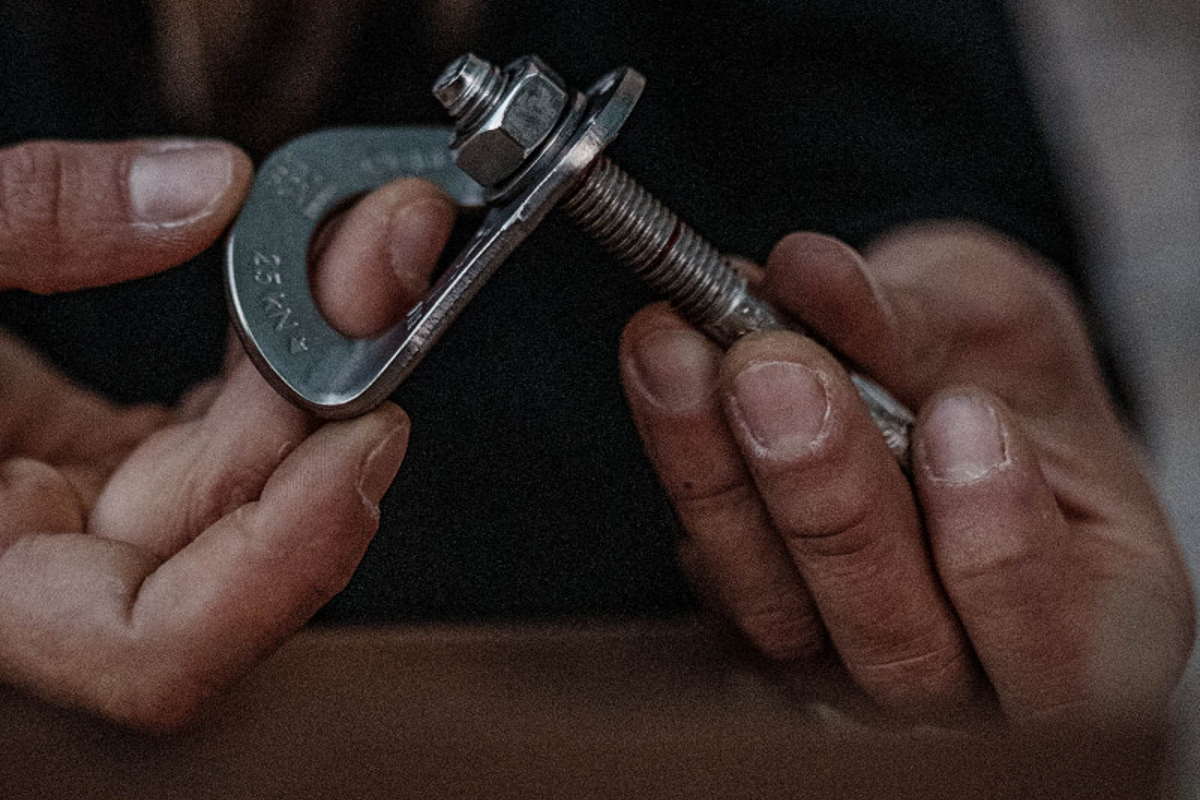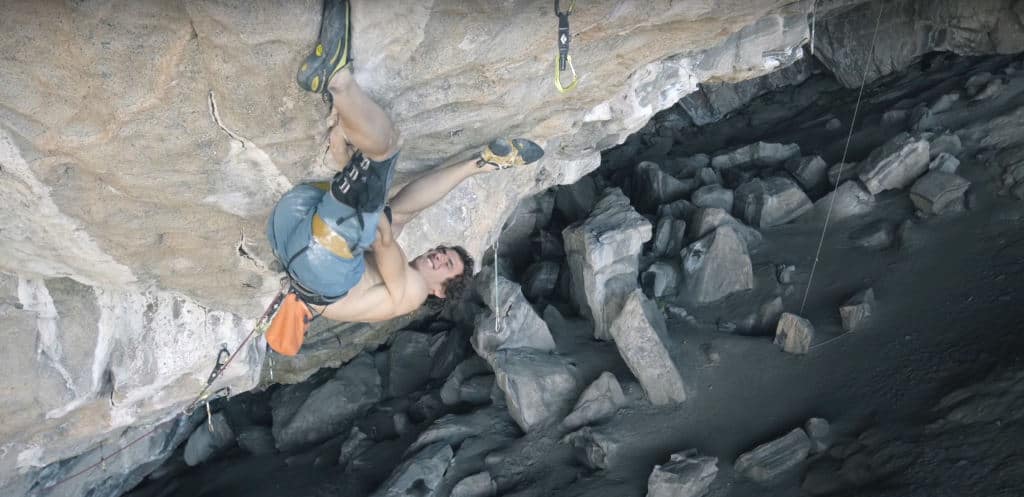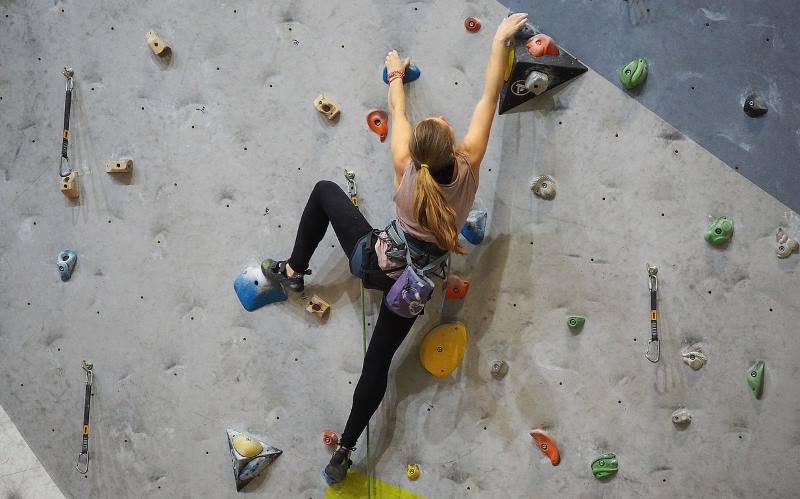Probably the most common question about climbing aside from “isn’t that dangerous” is about how rock climbers get down after going up. It’s actually much simpler and safer than most people think.
How Do Rock Climbers Get Down?
Most of the time climbers get down from a wall by simply lowering or rappelling off of the top using a fixed anchor. A fixed anchor is normally a couple of bolts drilled into the wall with lowering rings or chains connecting them. There are a few methods depending on what gear is at the top and how big the wall is.
The big misunderstanding here is most people think that a climber’s rope is only as long as the wall is high. Normally the rope you climb on is at least twice as long as the “pitch” – which is one section of a route. That allows the rope to go all the way to the top and back down like in a pulley system.
How Do Free Climbers Get Down?
You probably mean how do free solo climbers get down. Free climbing means using ropes and climbing using your hands and feet, without pulling on the gear in the wall. Free solo climbing is climbing without any ropes.
Free solo climbers get down usually by walking down the easy side of the mountain. That’s what happened with Alex Honnold on El Cap. Sometimes free solo climbers down climb smaller climbs but that’s usually as part of doing laps for practice. Sometimes they’ll use fixed ropes from the top to rappel.
Walking Off
Depending on the area there is normally a way to walk down a less steep part of the rock formation. Areas with a lot of traffic normally have a clear little path to get down. Often a day of climbing means walking to the top, making an anchor, then rappelling or walking back down to the bottom to climb it.
A big day out climbing followed by a lush walk-off as the sun sets is one of rock climbing’s biggest draws.
Lowering
On most routes, the wall will have a set of metal lowering rings bolted into the rock at the top of the pitch. When the climbers get there they secure themselves to the top with a personal anchor system. They then thread the rope through the metal rings and their partner lowers them down.
The climber is tied to one end and the “belayer” is on the floor – or sometimes also attach to the wall lower down. The belayer then lowers the climber by controlling the rope with a belay device. This is also what happens in climbing gyms and is the most obvious answer to “how do rock climbers get down”.
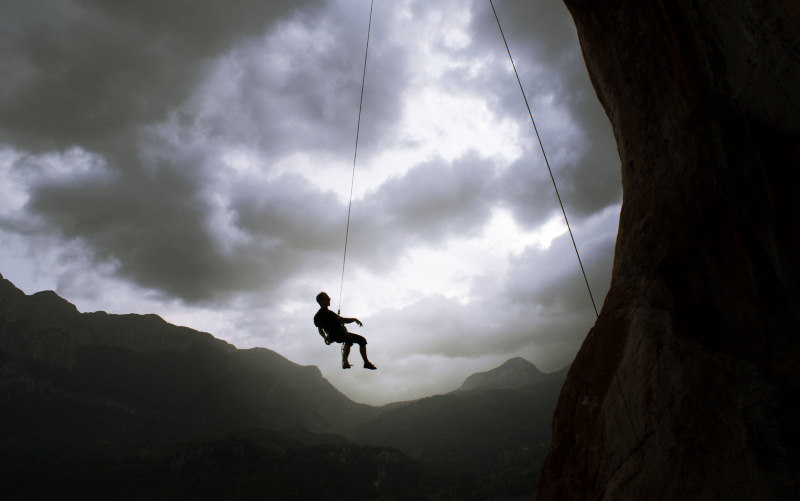
If there are multiple pitches (really big walls with many pitches per route – like in Yosemite) you can do multiple lowers or rappels. You get lowered to the next anchor down by your partner then lower your partner – repeating the process until you are on the floor.
Rappelling / Abseiling
For most multi-pitches or in Trad (traditional) climbing the climbers will rappel or abseil instead. The two terms mean the same thing. Instead of your partner lowering you, you lower yourself on the rope.
Rappeling is very simple. The climber threads the rope through the anchor and makes sure the ends of the rope are the same length – i.e the middle of the rope is at the anchor. They can then use a belay device like an ATC, figure eight, or even just a spare carabiner or three to attach themselves to the rope.
The climber uses the belay device to create friction, manually allowing enough rope to go through so they are lowered safely and slowly. You can even rappel on one side of the rope to rappel further but that’s a bit harder to control as well as tricky to get the rope down.
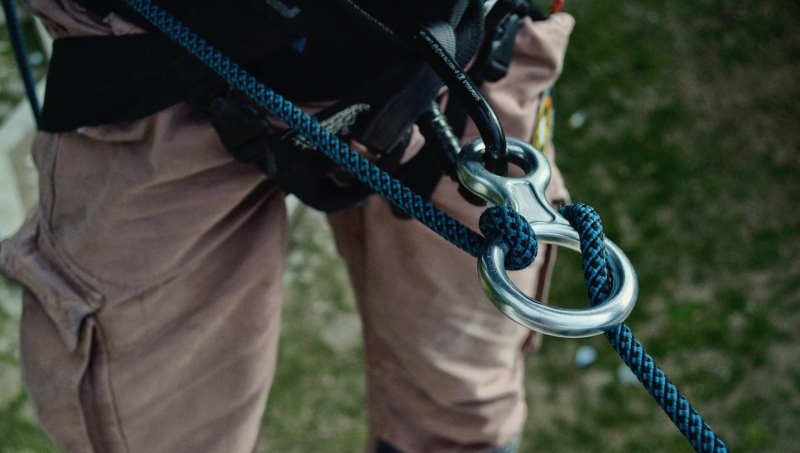
How Do Climbers Get Their Ropes Back?
When the climber gets to the floor and needs to get their rope back they simply pull one end of the rope down. The other side will slip through the anchor at the top and fall to the floor. Climbers keep a hold of the other end or tie it into an anchor so they don’t drop the entire thing.
On routes with lots of jutting rocks or trees/foliage, it can happen that the falling rope gets stuck midway. Most of the time some creative rope whipping will pull the rope down – hopefully without pulling down any loose rock. Climbers get their ropes back in this case by either using part of the rope or calling for help!
Types Of Anchors
In Sport Climbing there are normally fixed metal anchors bolted in that are meant to be used for years. Sport Climbing also has bolts in the way every few meters. In Trad Climbing some places allow fixed metal anchors (only for lowering) but there are many different ways of making your own anchor.
Most Trad routes have an anchor made of some cord, rope, and a carabiner or two. This is mainly wrapped around a tree, through holes in the rock, or even around a boulder at the top. Fabric degrades pretty fast in sunlight and bad weather so locals try to replace these every so often. Trad climbers tend to carry spare bits of cord and carabiners to make an anchor if needed.
Other Trad routes just have a tree or rock that’s “bomber” (bomb proof) that they’ll use to rappel from. As long as the middle of the rope is around the tree/rock and it doesn’t rub when the climber rappels it’s fairly safe. They then just pull one side of the rope down like other methods.
You can also leave your “protection” like cams and nuts in the wall for an impromptu anchor. This means weighing up how much expensive gear you are happy to leave vs how safe you want to be.
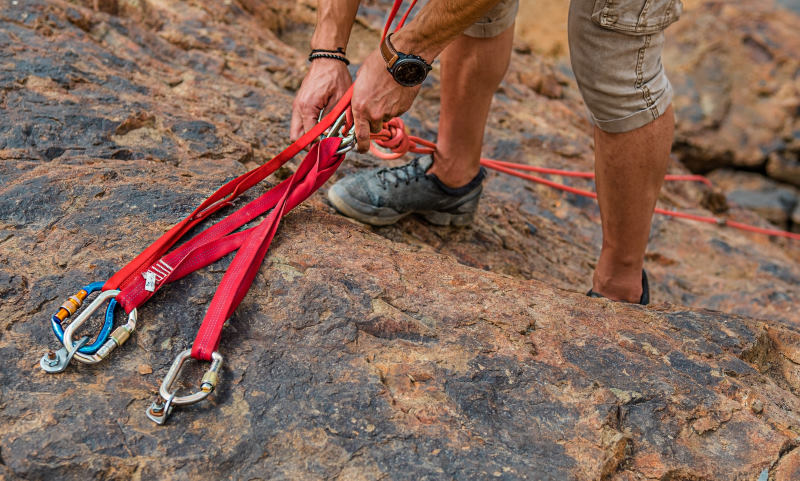
Down Climbing
A very uncommon way of getting back down is to downclimb. Literally just climbing back down. On technical rock climbing routes, this can be very dangerous because you can’t see the footholds as well as when you’re going up!
Generally, people only down climb when they are training, free soloing, or when there’s been an accident or dropped rope. In mountaineering, you just walk the route back down. Sometimes mountaineers or hikers will take the opposite route to rock climbers by walking up the easier side and rappelling back down the steep cliff face.
How Do Climbers Get Down From El Capitan?
On El Capitan most climbers walk back down by getting to one of the main trails down to camp four. Before a multi-day climb the team will probably have already hiked to the top to stash water and food up there, as well as on certain ledges on the route to make things easier.
When Alex Honnold did his free solo of the Nose route on El Cap he walked back down, as did Tommy Caldwell and Kevin Jorgeson on the Dawn Wall. They had all left some gear or food/water bits on the route so they either got the crew and cameraman to help them or went back the next day and jugged up the fixed lines to retrieve it.
Climbing Terms & Gear
- Belayer – Belay comes from the French word meaning to stop. A belayer controls one side of the rope to give enough rope for the climber to move up, hold the rope if the climber falls or rests, and lower the climber on the rope coming back down.
- Belay Device – A small metal device that attaches to the belayer’s harness and the rope. It allows the belayer to use friction to stop a climber’s fall or control the lowering speed.
- Rappel Device – A metal device for lowering yourself by rappel/abseil. A belay device in climbing normally doubles as a rappel device too. You can buy specific rappel devices that give you more control.
- Figure Eight – A popular and simple rappel device often used for caving, canyoneering, and military rappels. Can be used to belay as well.
- Anchor – Anything fixed to the top of a route or pitch that is used to lower or rappel from.
- Chains – In Sport Climbing you’ll often find two bolts drilled into the wall, attached to each other by chains. Sometimes you can lower directly through the chain links or specific rings or bulky carabiners. Many climbers refer to any bolted anchor simply as the chains.
- Carabiner – A metal oval that opens on one side. Has many uses and types in rock climbing. The opening gate can normally be locked and is handy for securing yourself to the anchors, or attaching a belay/rappel device to your harness – Read What Is A Carabiner?
More Climbing Jargon
– What Is Free Climbing?
– What Is Climbing Beta?
How Do Climbers Get Their Gear Back?
Climbers normally retrieve the gear they placed by collecting it as they lower back down. They lower using a fixed anchor at the top or by wrapping rope around a tree or rock. In some cases, rock climbers get their gear back as they belay their partner up after them.
Sport climbers take quickdraws with them and clip those into bolts that are already drilled into the wall. When they lower they simply unclip those and attach them to their harness.
In Trad Climbing normally the belayer climbs up after the first climber (or the leader) and takes the protection out as they go up. The pair then rappel down from the top one by one, leaving
How Do Climbers Get Their Anchors Back?
By anchors, you probably mean the gear that climbers put into the wall. The above answer covers this. The anchor is normally a fixed one at the top that you don’t need to remove. Sometimes though climbers have to leave an anchor made of expensive gear to get down if there isn’t already one there.
In that case, it’s often not possible to get it back. You can go up again another time, make another anchor with cheaper cord or fabric – or even drill in bolts if it’s allowed in the area – and retrieve the expensive stuff. However, normally you just sacrifice the gear so others can use it in the future.
How Do Climbers Get Down From Everest?
Everest climbers get back down the same way they came up. There is no easy way down as the way up already takes the path of least resistance. There are many problems getting down and a huge amount of the deaths on Everest are climbers coming back just after the summit.
The main problem is simply that people put everything they have into getting to the top. It’s easier getting down but still incredibly hard. Being so exhausted means people end up stopping to rest and never getting back up. Getting caught in bad weather while this happens is fatal.
